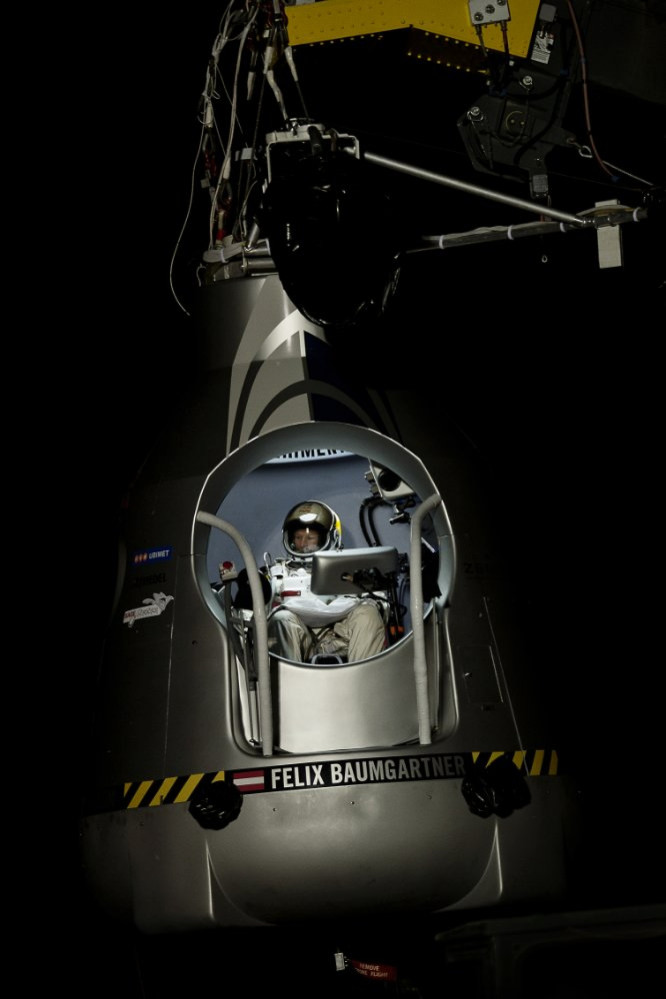Wind Delays Baumgartner Jump From Stratosphere: Why Weather Conditions Are Critical

Austrian daredevil Felix Baumgartner will have to wait another day to defy both death and the sound barrier as gusty winds on Tuesday foiled his plan to ride a balloon nearly 23 miles above the surface of the Earth before jumping out.
The crew on the ground aborted the mission at around 1:45PM Eastern due to wind gusts that noticeably buffeted the launch balloon as it sat on the runway.
One of the radio systems Baumgartner uses to communicate with the ground crew also appeared to fail on Tuesday.
43-year-old Baumgartner is attempting to top the previous record for highest, longest and fastest skydive, set in 1960 by Joseph Kittinger, who dived 19.5 miles from a balloon as part of the US Air Force’s Project Excelsior. The jump, sponsored by energy drink maker Red Bull, was already pushed back one day after a cold front moved in on Monday.
Early Tuesday morning, the signs did not look good. Meteorologist Don Day told the Associated Press on Tuesday that while the winds on the ground were cooperating, the winds at 700 feet, where the top of the balloon will reach once inflated on the ground, were a less hospitable 20 miles per hour.
“We need 3 mph or less at 800 feet,” Day told the AP.
Wind conditions at launch are a particular worry for the mission because they could drag the capsule along the runway, possibly damaging it. The winds also pose a problem at high altitudes, where low temperatures – between -70 and -50 degrees Fahrenheit at an atmospheric layer called the tropopause -- can make the balloon brittle, meaning a sudden gust could rupture its thin surface. Winds can also blow the balloon off course.
Even with cooperating weather, Baumgartner’s equipment will be the main thing standing between him and death. Even a tiny rip in his pressurized suit could expose him to low oxygen, freezing temperatures, and extremely low air pressure that could have created dangerous bubbles in his blood.
Others attempting to break the free fall record have met with tragedy. New Jersey man Nick Piantanida’s facemask blew out at 57,000 feet above ground during his 1965 attempt to break Kittinger’s record. The lack of oxygen damaged his brain, sending him into a coma, from which he never recovered. Russian jumper Pyotr Dolgov also died in a similar attempt in 1962.
And even if the equipment works, there are natural forces that could still muck up a dive from 120,000 feet.
Baumgartner is eating low-fiber foods before his jump to try and minimize the amount of gas in his digestive tract, which would expand in his body while up in the stratosphere due to the low air pressure. Before making the ascent in the balloon, he breathed pure oxygen for two hours to eliminate nitrogen from his bloodstream, which could also expand at high altitudes.
One big danger to Baumgartner is losing control of his free fall and entering what’s called a “flat spin,” in which he’d start to spin around laterally, pushing blood into his head and feet and creativing extreme negative gravitational force. Flat spin could cause something as mild as a headache, or something as dire as bursting his eyeballs from the buildup of fluid and blood.
This is hardly Baumgartner’s first rodeo. He already holds the record for highest parachute jump from a building, which he set in 1999 by jumping off Malaysia’s Petronas Towers, and has jumped off of the hand of the statue of Christ in Rio de Janeiro.
© Copyright IBTimes 2025. All rights reserved.





















